Tara practice is among the most beautiful and inspiring practices in Mahayana Buddhism, but — why are there so many Taras? In every Mahayana tradition, there are many aspects or emanations of Tara — seemingly one for every fear or danger sentient beings face. Is it because she is so beloved? Probably. Is it because she represents the activities of all the Buddhas, and therefore emanates in many helpful ways? This is certainly true.
21 Taras are well known, but there are also 108 Taras, 1008 Taras, and many more. Even within the 21 Taras, there are five main lineages of practice, each visualized slightly differently — although you could group (for simplicity, as we’re doing here) several lineages under the teachings of Atisha and Jigme Lingpa (Nyingma) as they are similar and use the same names.
NOTE: These images are copyright Lasha Mutual. Please visit her website for information. They are available in book, poster and card form.
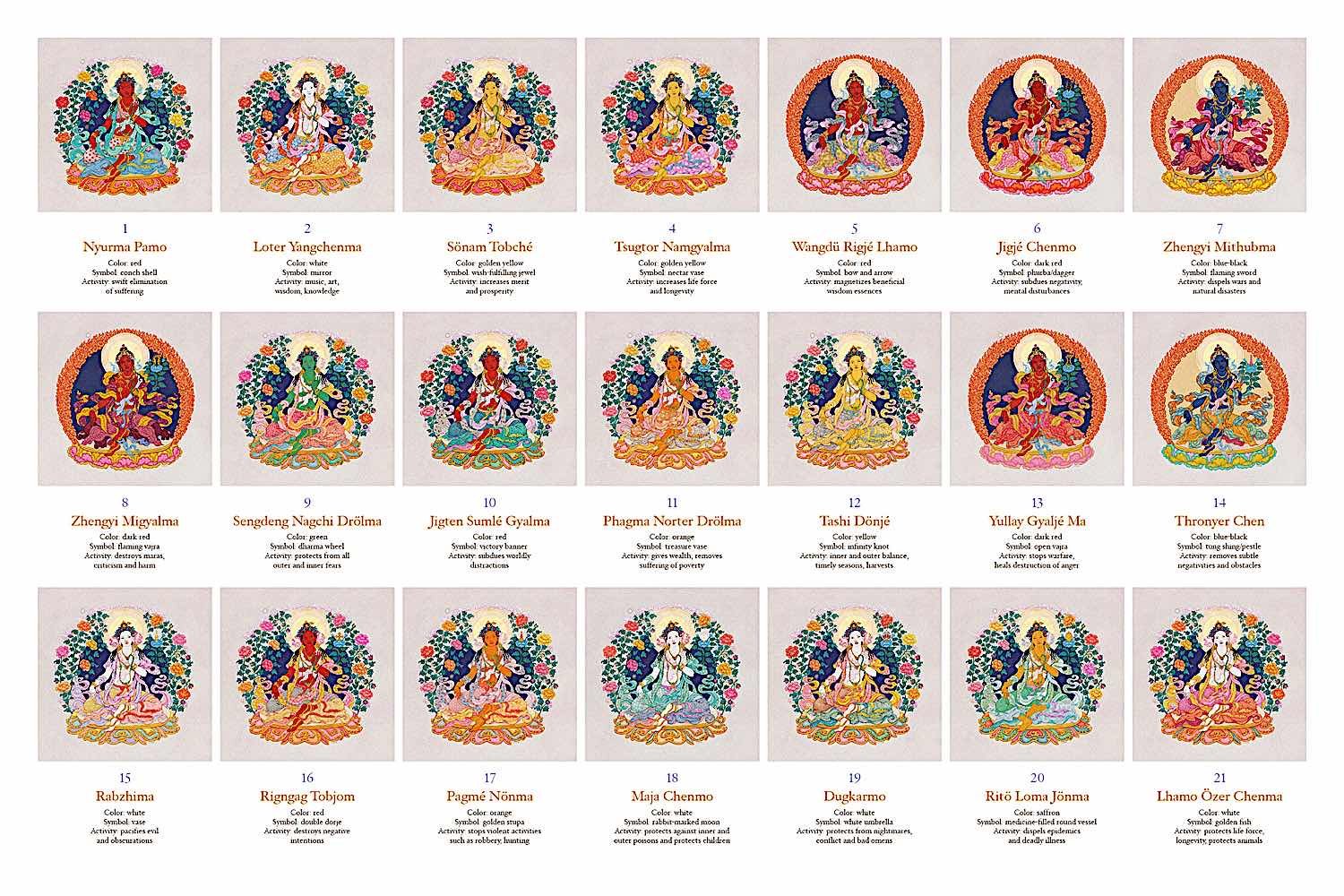
The 21 Taras are presented individually — by amazing artist Lasha Mutual (these images appear in the video and in detail below). This is in the style of the Nyingma Terma lineage, which is closely aligned with Atisha’s lineage. The key difference is in the attributes. Both Atisha and Nyingma lineages use color, but Atisha’s revealed visualization mostly involves vases, while Nyingma’s lineage terma visualizes with a symbol (such as a vajra or an endless knot) on top of the lotus held in Tara’s hand. To see more of Lasha’s art, see the detailed images or video below, or visit her website>>
It may seem unnecessarily complicated, but the symbolism is quite profound. Tara emanates in these countless forms because we have countless fears and obstacles. None of our fears are unimportant: epidemics, war, poverty, the list is endless. Fortunately, Tara is heroic and tireless! From our end, all of our obstacles must be faced with heroic resolve — Tara’s resolve.
21 TARAS EVENT NOTICE
If you are interested in the 21 Taras practice according to Atisha, Venerable Zasep Rinpoche author of Tara in the Palm of Your Hand, will be granting empowerment via Zoom. This is a by donation event at Gaden Choling on July 2, 2022, at 6 pm ET. Registration is here on Eventbrite>>
- In part 1 of this series, we focus on the Praise to 21 Taras — which is consistent across all lineages — and the four language versions: Sanskrit, Tibetan, English (non-musical), and English for chanting. In part 2 we compare the differences, Tara 1-21 between Atisha lineage, Nyingma Terma lineage, and Surya Gupta lineage.
The 21 Taras praises in an English video with Atisha/Nyingma- style visualizations
Tara’s activity in our lives is why we should practice
Why should we practice? Tara, as an aspect of the Enlightened Buddhas, is the one we go to for activities. She is literally the activity of all the Buddhas. Anything to do with Karma and activity is her “Domaine” — which, let’s face it, is everything in our lives. As much as we talk about the Bodhichitta goal of Enlightenment for the benefit of all sentient beings, to get there, we need Tara’s help. And, never fear, if you don’t have time for the 21 Taras praise (which takes moments each day!) simply chanting her mantra will bring you into Tara’s loving and compassionate, motherly care.
Om Tare Tuttare Ture Svaha
Om Tare Tuttare Ture Soha (Tibetan pronunciation)
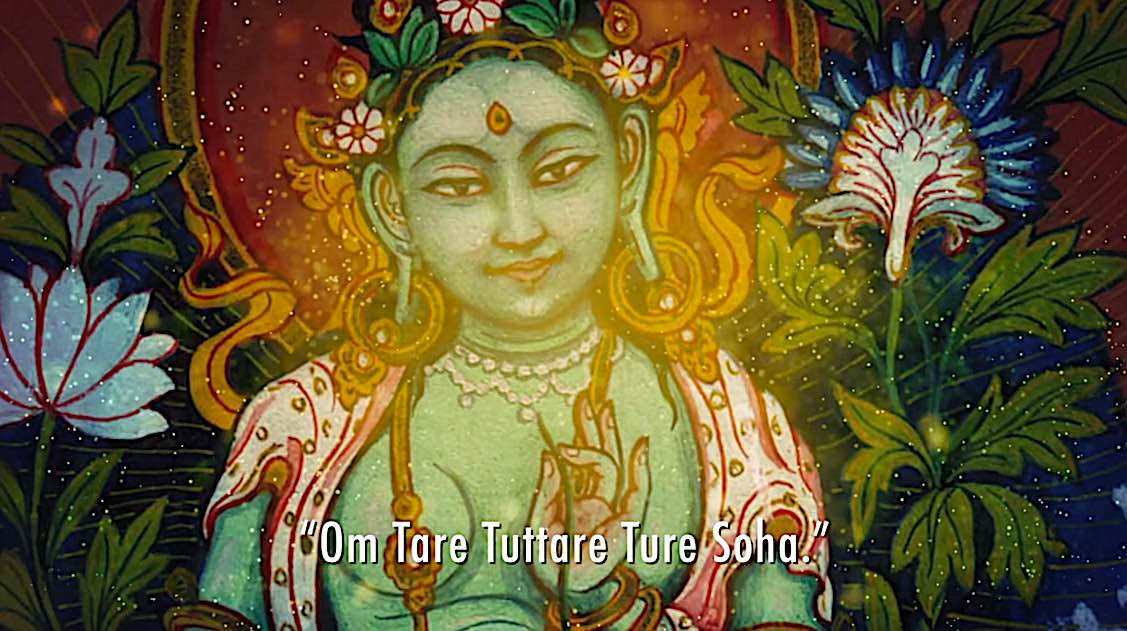
Om Tare Tuttare Ture Soha is Green Tara’s mantra. Green Tara is the rescuer, the mother of all the Buddhas and of all beings — Wisdom is the mother of Buddhas — and she is known for her quick action on behalf of those who call her name for help.
Simplified 21 Taras!
Fortunately, the 21 Taras practice — which is a daily practice to most Tibetan Buddhists of most lineages — has a simplified visualization and practice as taught by the great Mahasidda Atisha, which focuses mostly on color and minor attributes. The lovely Nyingma style is more-or-less the same Taras, names, and colors, but adds a lotus with a meaningful symbol on the blossom (such as a flaming vajra or a Dharma wheel.)
Unlike the Surya Gupta lineage, which requires 21 days for initiation (one for each Tara) due to the complexity of visualization, Atisha and Nyingma lineage 21 Taras can be practiced by anyone. The complexity is reduced to a level anyone can practice — even those limited by time constraints. This means the profound realizations, powerful activities and pleasing devotional aspects are accessible to everyone.
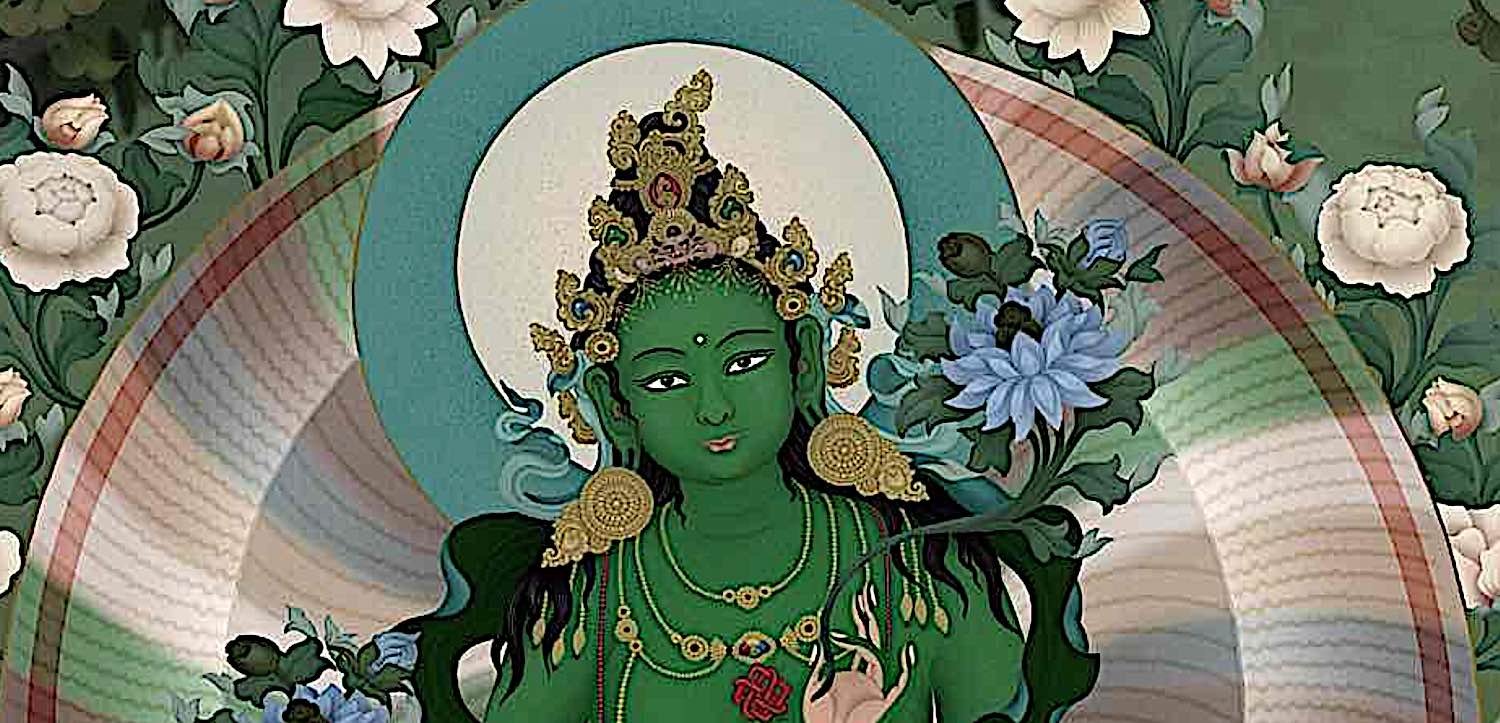
Tara detail from Jampay Dorje’s painting of Green Tara. To view his amazing art, visit his website>>
The Atisha and Nyingma (and related) lineages of 21 Taras became the most popular and important in all Tibetan Buddhism, in part, due to devotional simplicity. With the other main system, which comes down in unbroken lineage from the great Mahasiddha Surya Gupta, the 21 Taras are visualized in much more detail, with various appearances, sometimes multiple arms and different attributions. (If you are interested in this practice, please see our 3-part series on the Surya Gupta lineage, found here>>)
No matter which tradition or version of the 21 Taras you practice, the essence is the same — that each one is there to protect you from a different kind of danger or obstacle. They are all important, and each one has something valuable to teach us. At the same time, all are Tara — in other words, if you are in trouble, just call out Tara’s name!
Quick Comparison: Atisha and Nyingma
Although we’ll covering this detail-by-detail in part two of this series, it’s worth pointing out the major difference in visualization between the Nyingma (top below) and the Atisha (bottom). In
Nyingma lineage Tara is red and holds a lotus stem in her left hand on top of which is her symbol, a Conch shell:
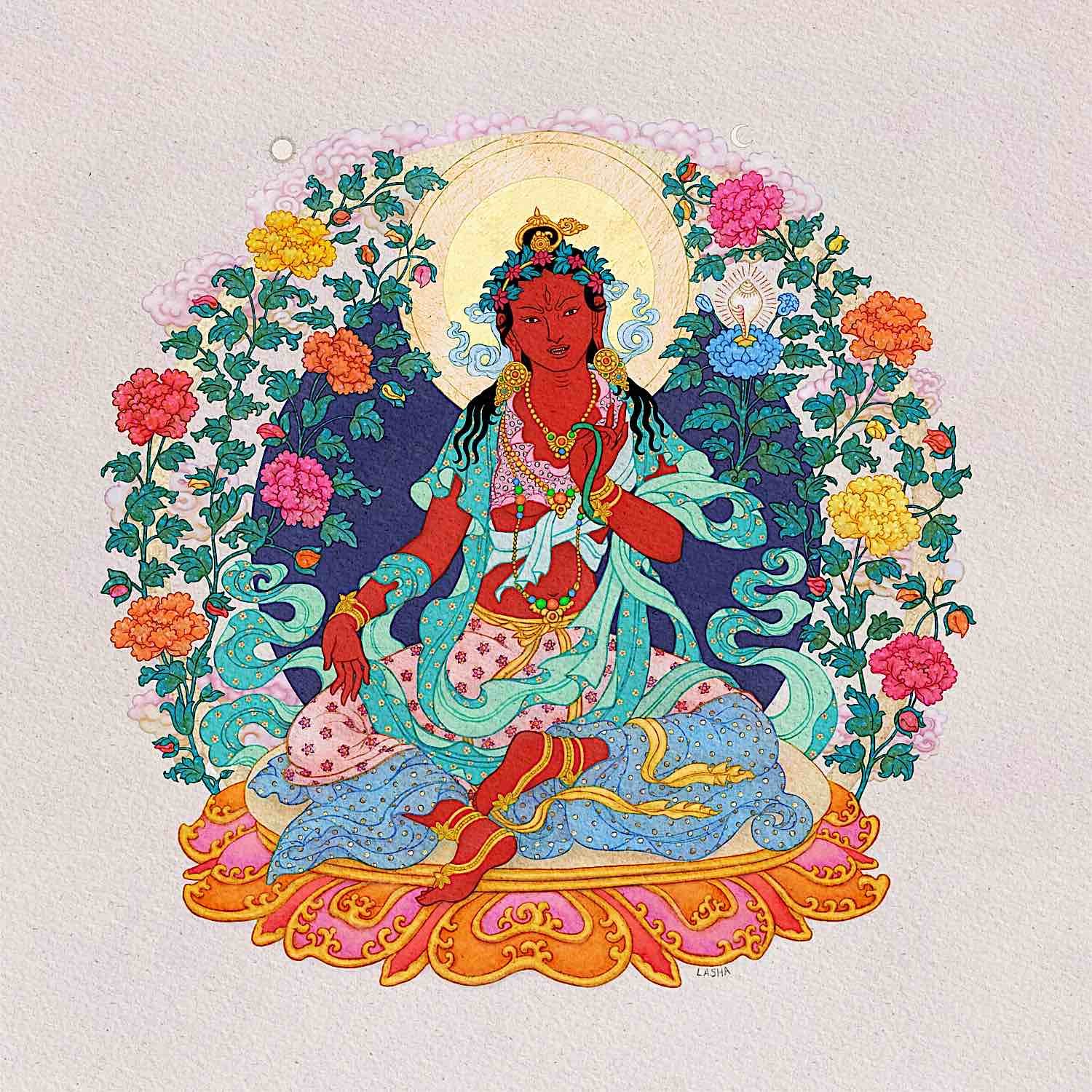
Tara 1 in the Nyingma terma lineage visualization has the sacred conch shell on top of a lotus in Tara’s left hand. Art by Lasha Mutual. To see more of her art, each of the 21 Taras, separately is used to illustrate the 21 Tara praises below. You’ll also find these beautiful images in the video above.
Atisha lineage Tara is red with a vase in right hand:
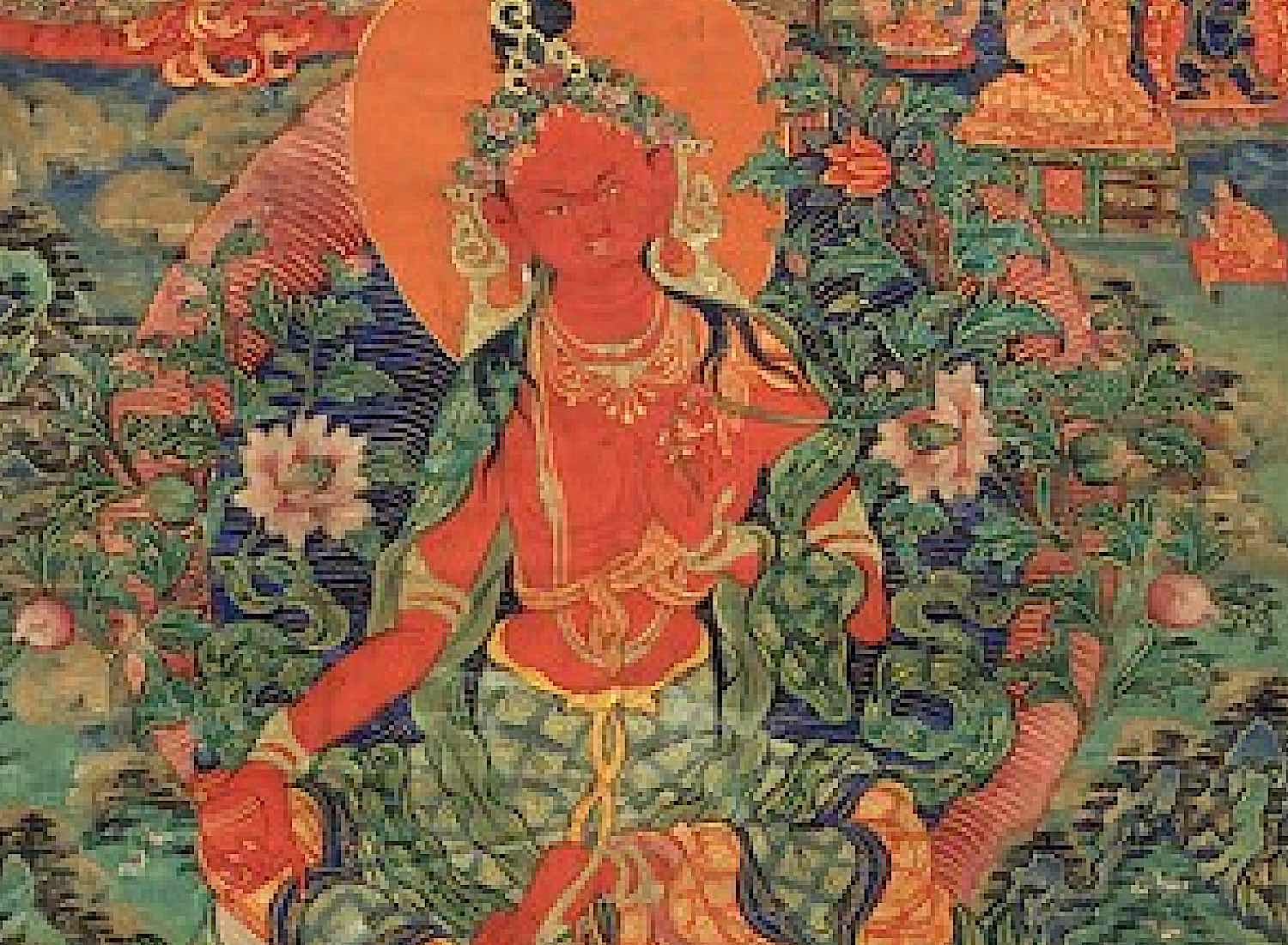
Atisha lineage visualization for Tara 1 is red with a vase in the right hand. Thangka from Himalayan Art.
A pleasing, profound, powerful, precise practice!
21 Taras Lineage practice is a profound, powerful, precise, pleasing daily practice. It is also a Mahayana found in all of the Tibetan Buddhists of most lineages. The 21 Taras practice is one of the most popular and important in all Tibetan Buddhism.
The praises to the 21 Taras contain the heart of Atisha practice, when combined with visualizations of the Taras in their different aspects. Even if Atisha’s clear and concise practice seems difficult — it is enough to remember that all Taras are Tara. The emanations symbolize her many activities and powers and compassion.

21 Taras on one thangka in the Atisha lineage style, with Green Tara in the center. Art from Himalayan Art.
Sanskrit, Tibetan and English, plus English?
Teachers are clear that it doesn’t matter if you chant these in the original Sanskrit — although it is profoundly beautiful — in Tibetan, or in English. The main complication with English, if you wish to “chant” it musically — which, let’s face it, makes it more memorable and beautiful — is the number of beats. While Sanskrit and Tibetan both have eight beats per line, making musical offerings easier, the English translations for the most part are uneven — 16 on one line, 8 on the next. This is a language structural issue.
In this feature, we will provide the Sanskrit praise, Tibetan Praise, and TWO English versions — one of which we’re produced as a beautiful chanted version. The first English version is the commonly accepted translation with uneven beats. If you choose to practice this one, it’s best to just speak it, rather than try to chant.
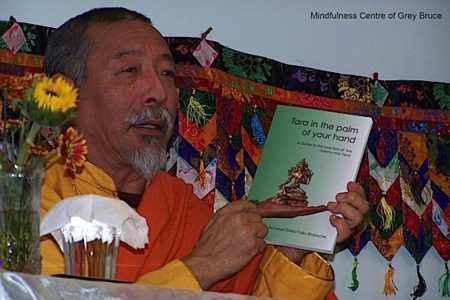
Venerable Zasep Rinpoche teaching at a Tara weekend using the commentary book, Tara in the Palm of Your Hand, as a reference. The book is available on Amazon>
We also provide an 11-beat English version approved by Venerable Zasep Rinpoche (author of Tara in the Palm of Your Hand, and a notable “Lotsawa” or translator of both Tibetan and Sanskrit texts). This carefully went back and forth from editor to translator to ensure none of the intentions and meanings changed — and in the end, we had a beautiful eleven-beat version and melody. Please enjoy below.
Praises to the Twenty-one Taras
The praises as chanted and practiced today usually open with a lovely introductory verse sometimes called the praise of the mantra or just simply the homage to Tara. This honors the mantra, and some teachers advocate that if you are in a hurry, you can chant this several times instead of the entire 21 verses — but clearly, this is a compromise for modern, busy lives. If you have time, it is always best to chant the original 21 verses from the texts.
Then, the question becomes do you chant in Tibetan, Sanskrit, or English? Tibetan and Sanskrit are both 8 beats per line, and lend themselves to music. It’s one of the joys of Tibetan practices — its lovely musicality. Most English translations, as discussed, are irregular. Now, with an 11-beat version, you can chant the English version as well. (There are other versions of “English chant-able” as well, although some slightly change the “meaning’ of the translation.)
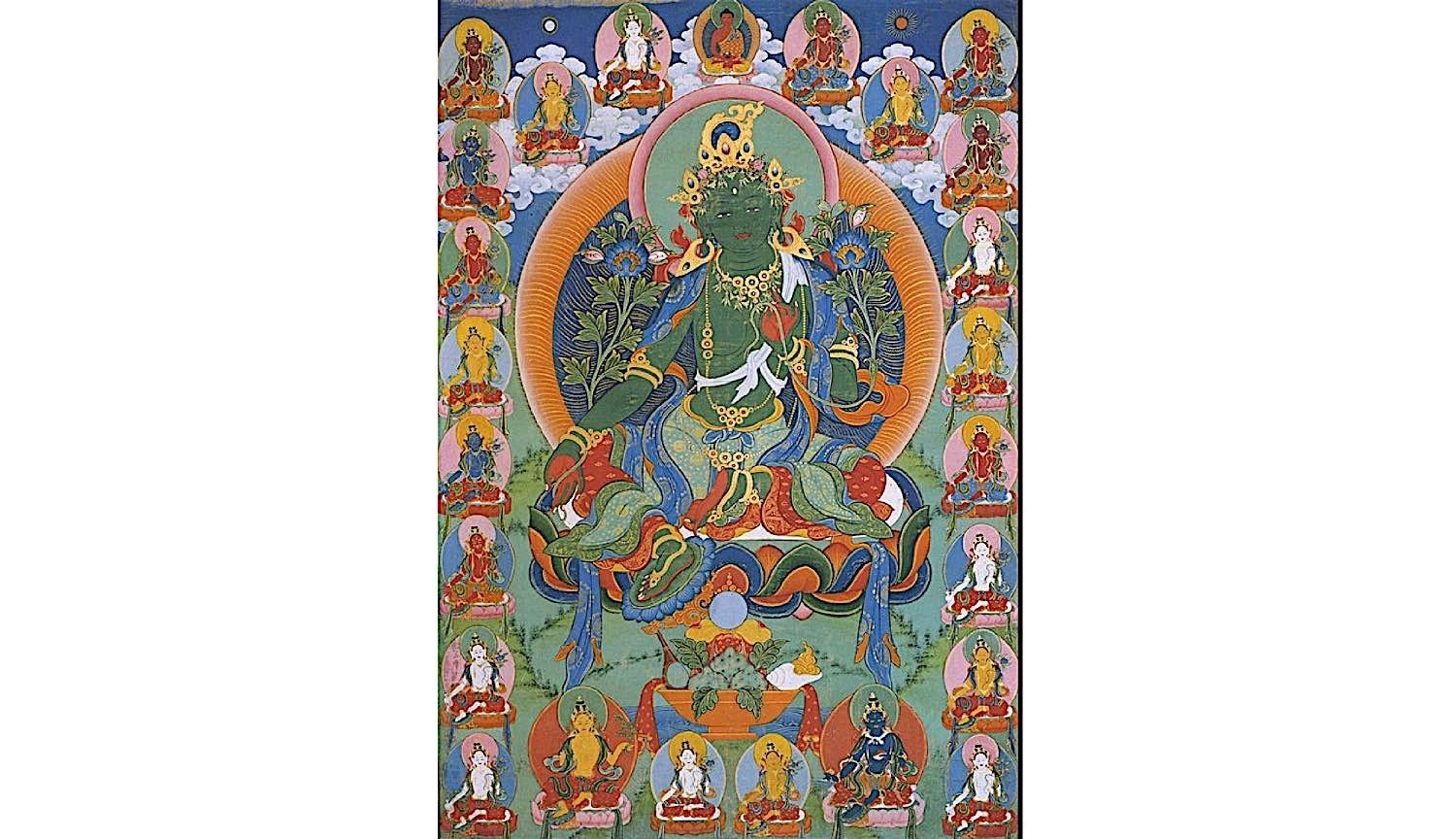
21 Taras according to Atisha lineage tradition on one thangka with Green Tara as the center of the mandala.
The Tibetan text and the non-equal beat English translations are courtesy of “Tara in the Palm of Your Hand” — an amazing book by Venerable Zasep Rinpoche.[1] The Introductory Tibetan praise is cited from Khenchen Palden Sherab and Khenpo Tsewang Dongyal’s “Tara’s Enlightened Activity” another amazing book.[2] The Tibetan version is from FPMT’s Praises to Twenty-one Taras practice. [3]
Whether English, Tibetan or Sanskrit, all are reproduced below.
NOTE: Sanskrit and Tibetan are hear transliterated in the Western alphabet for easier practice since many practitioners do not read Tibetan or Sanskrit text.
Pronunciation: If you don’t know the pronunciation of Sanskrit (and Tibetan) there are no silent vowels. An “h” following a consonant is normally aspirated, like “B-ha” rather than a silent h. “Thay” is never like “they” in English but rather “Tuh-Hey” For instance “Tare” is not pronounced “Tear” but rather “Tahreh.” Most vowels on short “e” is “eh” not “ee.” “A” is “ah” not “eh.” “I” is not “eye” but “ee”. Think “soft or short” — not long for vowels.
Praise to the Mantra
Before the main 21 Taras Praises, early commentaries added the praise to the mantra at the beginning. Think of this as an introductory, or a stand-alone practice, as many teachers say it is a powerful practice in its own right.
Sanskrit praise to the mantra
In Sanskrit (CAPS are on the actual words from the mantra, Om Tare Tuttare Ture Svaha.)
OM! Namas TARE Ture vire
TUTTARE bhaya na shane
TURE sarvart ha da TARE
SVAHA kare namo stute
(So, as an example, pronouncing the first line in the above verse would more or less be: Aum! Nah-Mahs Tah-ray Two-ray Vee-ray)
Tibetan praise to the mantra
CHAG TSHAL TA RE NYUR MA PA MO
TU TA RA YI JIG PA SEL MA
TU RE DON KUN JIN PE DROL MA
SO HE YI GE CHO LA DU DO
Normal English (nonchantable)
Homage to Tara, quick one, heroine. (9 beats)
With TUTTARA, you are the one who banishes all fear. (14 beats)
With TURE, the liberator who bestows all benefits. (15 beats)
With SOHA, I pay homage to you. (9 beats)
Chantable English (used in the video)
Approved by Venerable Zasep Rinpoche
Homage to Tara the Swift and Courageous, (11 beats)
You drive away all our fears with TUTTARE, (11 beats)
Saviouress fulfilling all aims with TURE, (11 beats)
With syllables SVAHA, we offer homage. (11 beats)
21 Praises in English – Chantable version
Since many are probably reading this feature for the 11-beats sung version featured in the video, we’re starting with this one. Try the music developed in 11 beats by Hrishikesh Sonar, or, if you’re developing your own chant, structure it for 11 syllables per line.
We’re just labeling Tara 1-21, since the names of the Taras vary between lineages:
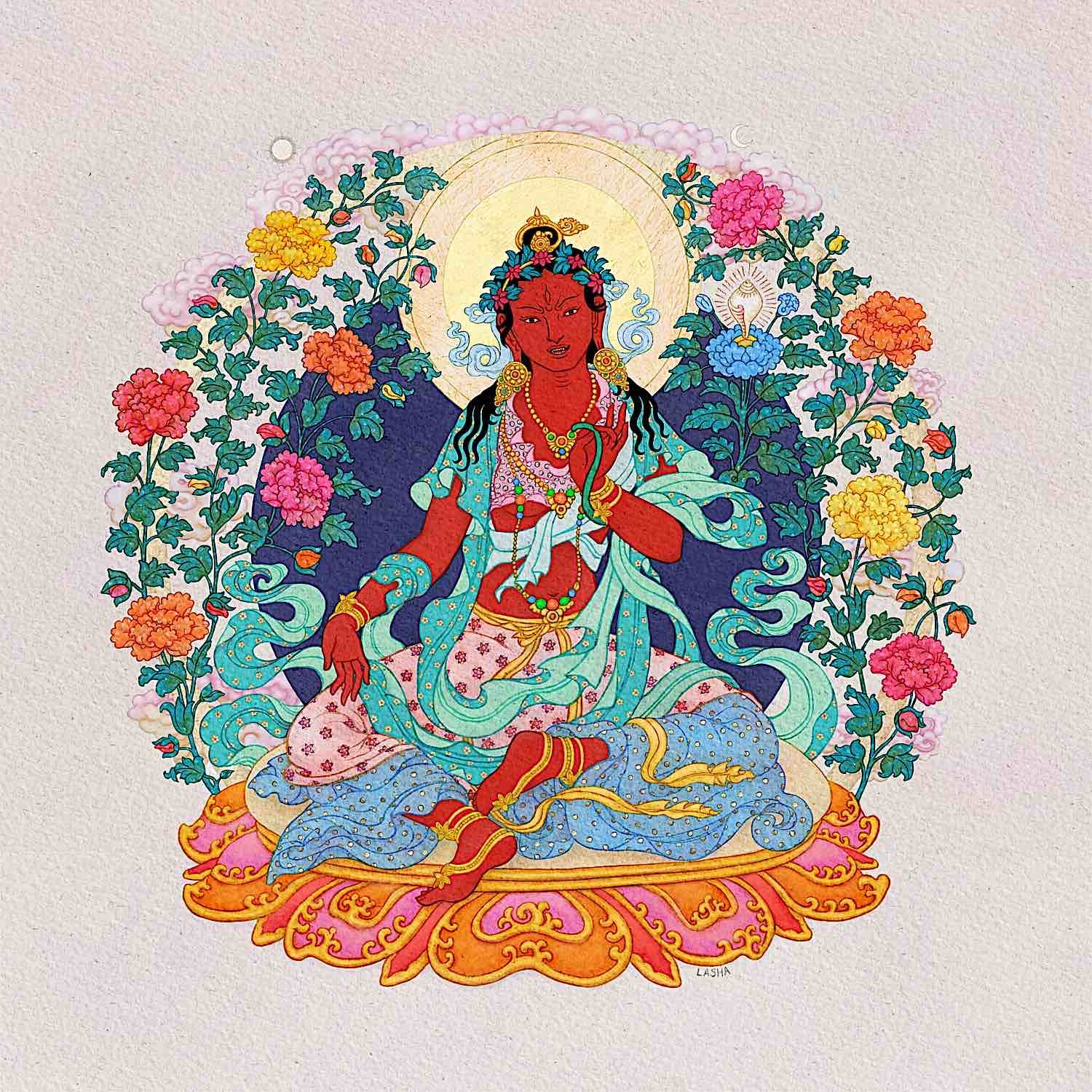
Tara who is swift and courageous Drolma Nyurma Pamo, red with a conch shell is for the elmination of suffering in the Nyingma tradition. Art by Lasha Mutual
Tara 1
Homage to You, the Swift One, the Heroine,
Your gaze is as quick as flashes of lightning
Who arose from the majestic carolla
From the Lotus face of the Lord of Three Worlds.
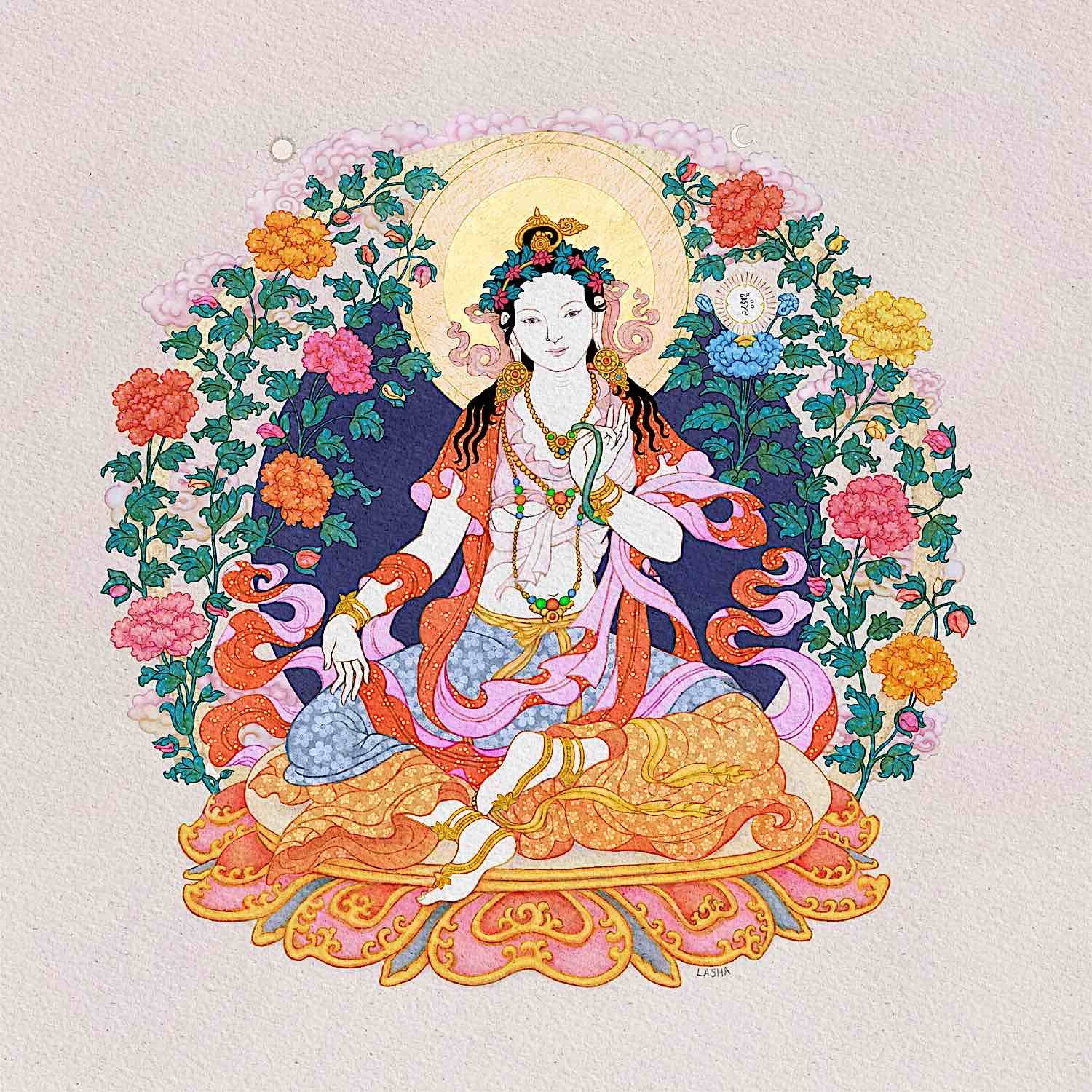
Tara 2 is Tara Sarasvati Drolma Yangchenma, white with a mirror, and is known for music, art wisdom, knowledge. Art by Lasha Mutual.
Tara 2
Homage to You with a face that resembles
The gathering of one hundred autumn full moons
And who with the brightness of stars by the thousands
Shines in a vast perfect light of resplendence.
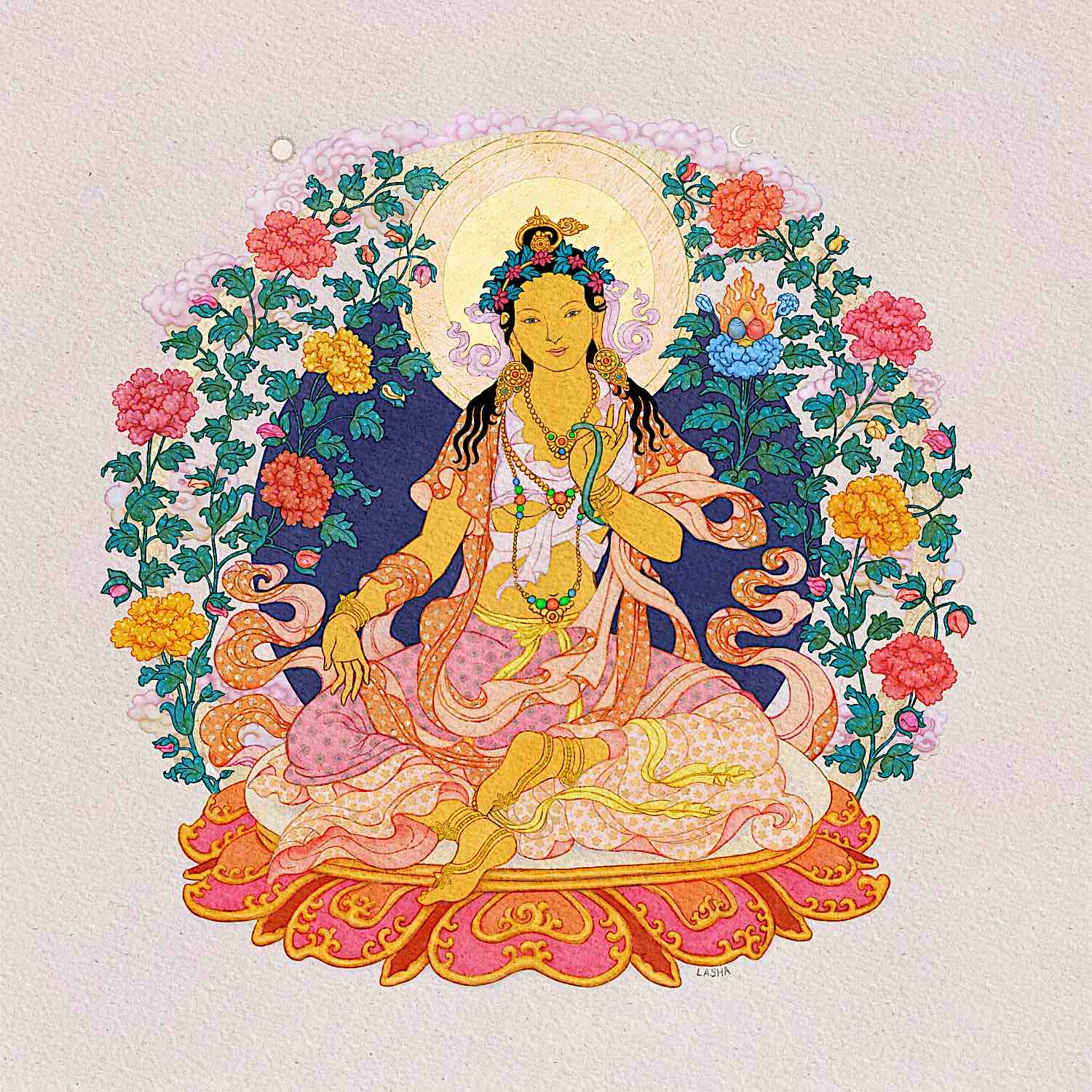
Tara 3 is Tara who grants supreme merit, Drolma Sonam Chokter, golden yellow with a Wish-fulfilling jewel. She increases merit and prosperity. Art by Lasha Mutual.
Tara 3
Homage to You divine golden-blue Goddess
Whose hands are adorned by water-born lotus.
Embody Six Perfections: Giving, Patience
Ethics, Concentration, Vigor, and Wisdom

In the Nyingma lineage, Tara 4 is identified with Ushnisha Vijaya and is called Drolma Tsuktor Namgyal, of golden color with a nectar vase of longevity nectar. Her activity is long-life and life force. Art Lasha Mutual.
Tara 4
Homage to You who crowns Buddha’s ushnishas,
Whose victorious actions have no limit.
Who has attained ev’ry transcendent wisdom,
On whom the Bodhisattvas themselves rely.
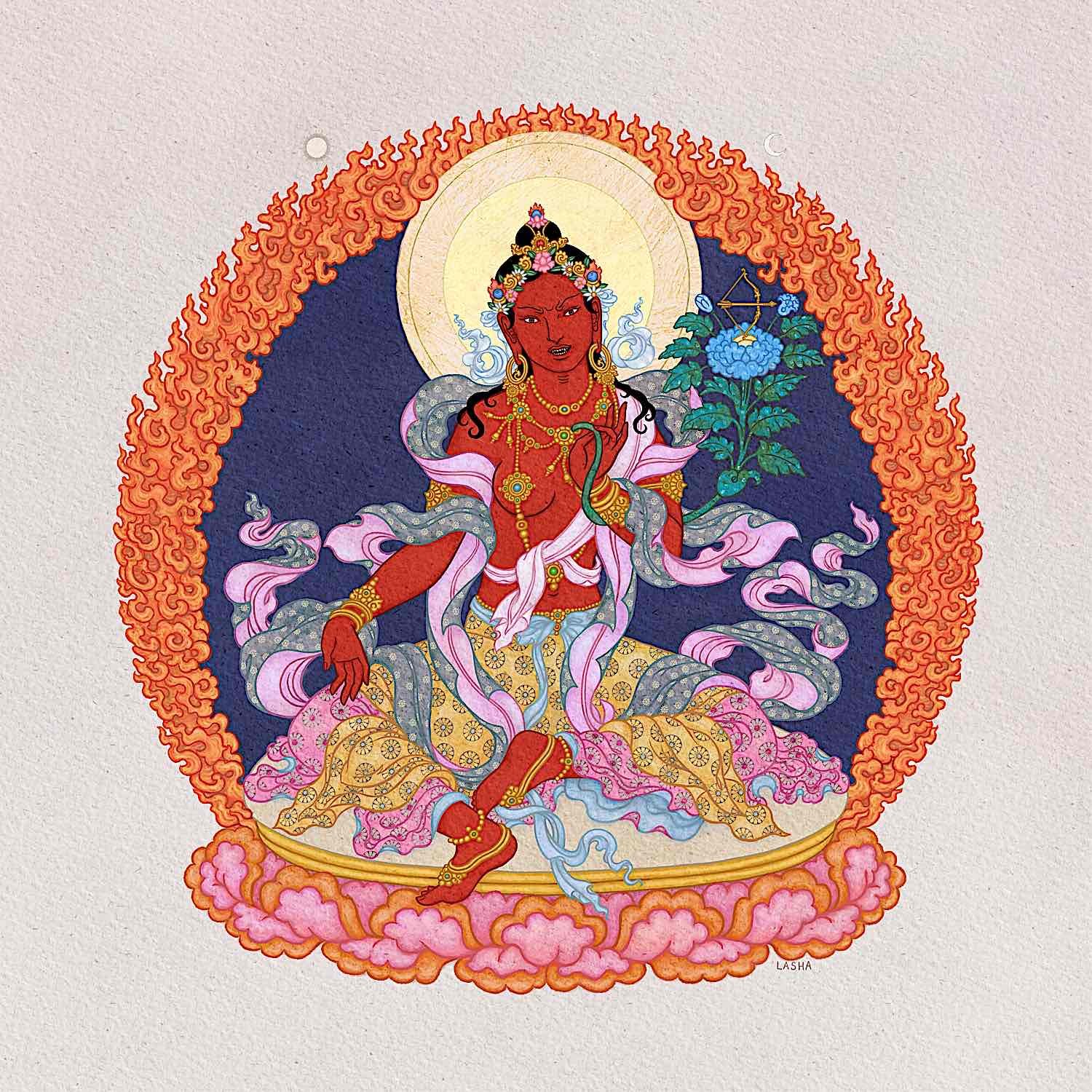
Tara 5 in the Nyingma lineage is associated with Tara Kurukulla, called Drolma Rikchema, with a red bow and arrow. She magnetizes beneficial wisdom essence.
Tara 5
Homage to You who with HUM and TUTTARA,
Fill all worlds of desire, direction, space.
Who with your feet press down on the Seven Worlds;
You subdue all beings under your power.

Tara 6 is Tara who destroys harmful influences, called Jikché Chenmo. She is dark red with a phurba dagger, and she subdues negativity mental disturbances.
Tara 6
Homage to You praised by Indra and Agni,
Brahma, Vayu, Ishvara and all the gods
All the spirits, zombies, and the smell-eaters,
Even the Yakshas give praise in Your presence.
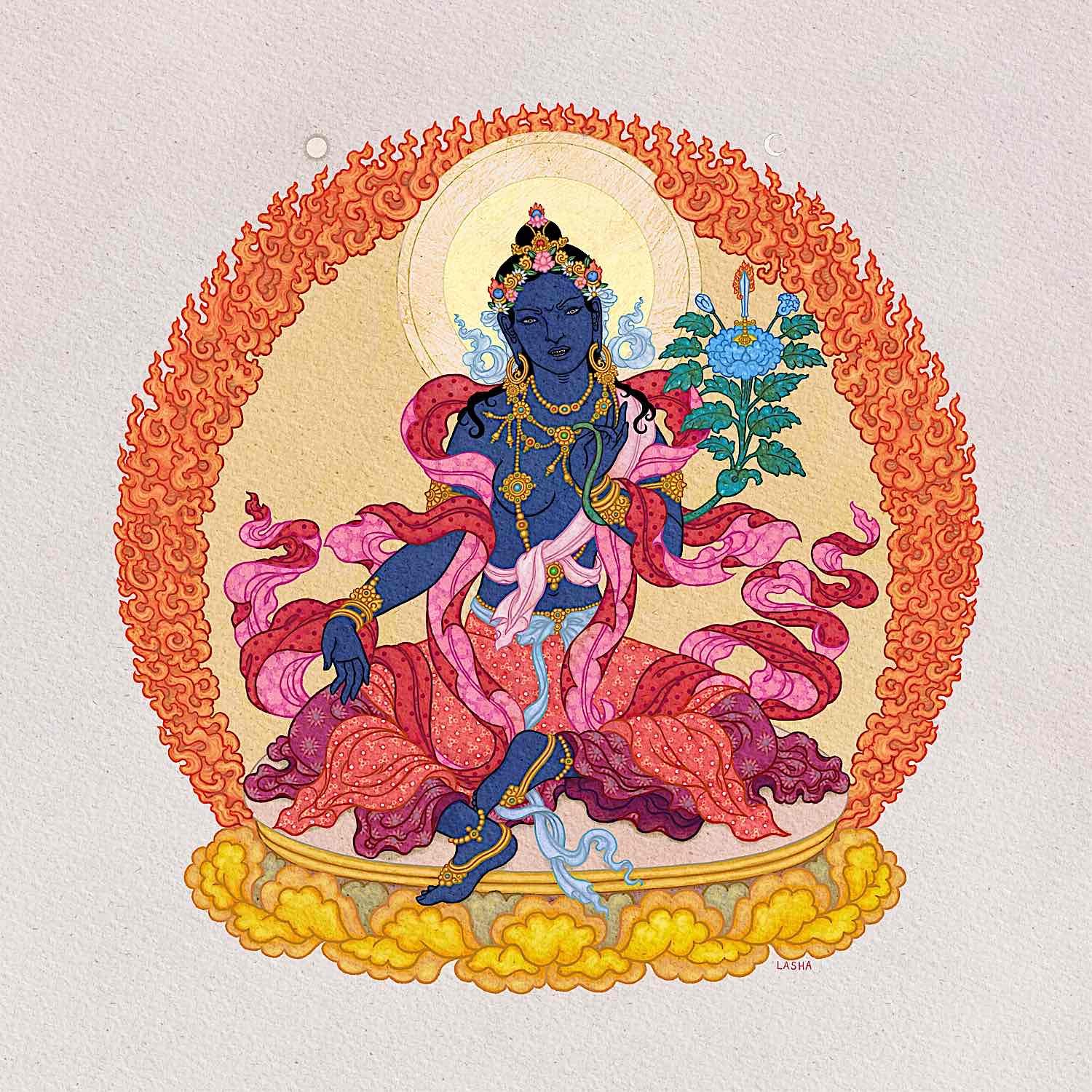
Tara 7 is Tara who is invincible, called Drolma Shyenkyi Mitupma. She is black, with a flaming sword, and her awesome acvitiy dispels war and natural disasters.
Tara 7
Homage to You who with the TRAY and PEY sounds,
Crush every magical wheel, evil forces,
Right leg extended and left bent, you trample,
You burn them completely in Your whirling fire.

Tara 8 is Tara triumphant over others, called Drolma Shyen Migyalwa. She is dark red with a flaming vajra, and destroys maras, harm, and criticism.
Tara 8
Homage to You, TURE, the Boundless Fierce One,
Who totally destroys leaders of maras.
Whose lotus-like face forms furious wrinkles,
You annihilate foes without exception.
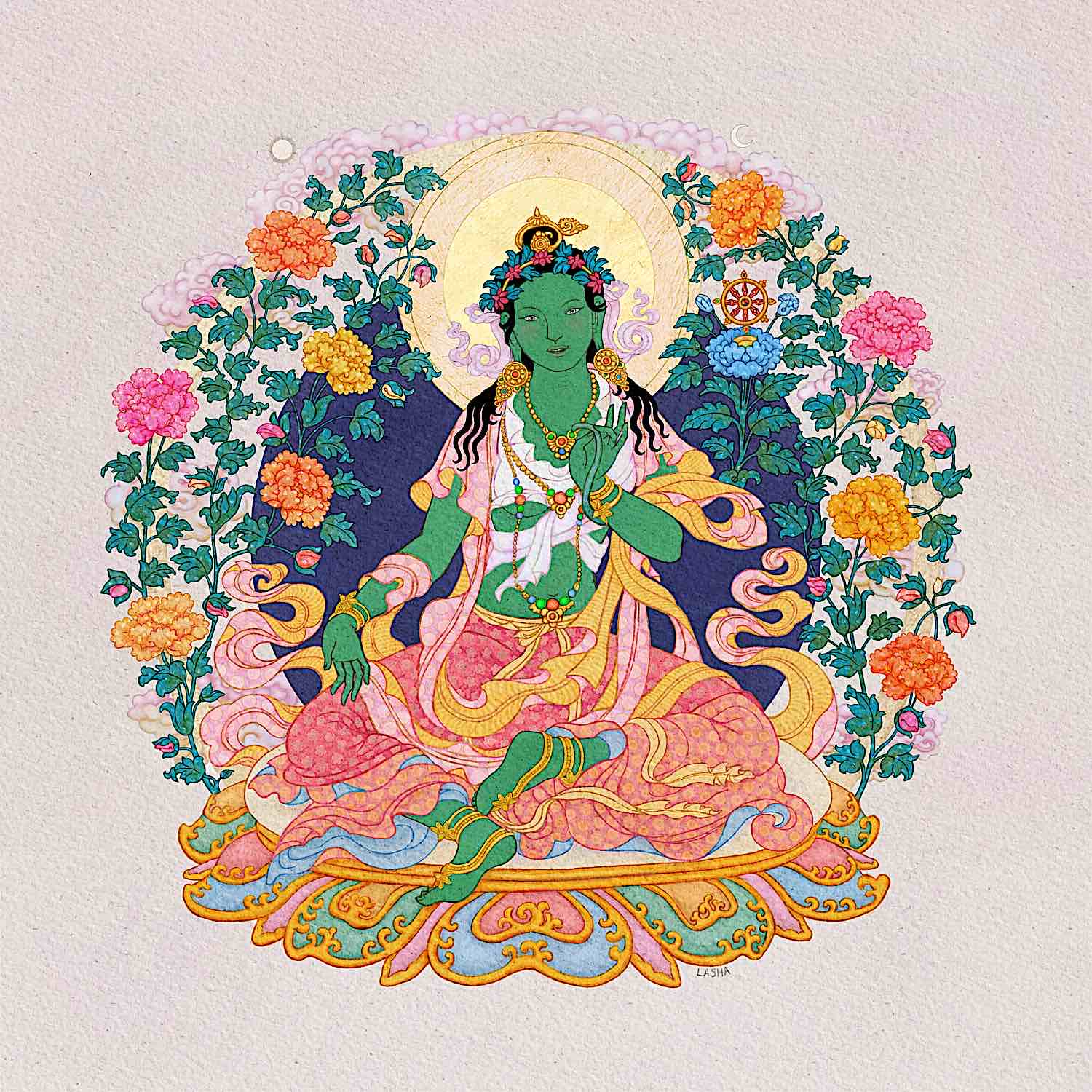
Tara 9, is Green Tara of the Khadira Forest, called Drolma Sengdeng Nakkyi . She is green, with a Dharma Wheel, and she protects from outer and inner fears.
Tara 9
Homage to You whose fingers held at Your chest,
Displaying the mudra of the Three Jewels;
Beautiful swirling light in your precious hands
Dharma wheels connect every direction.
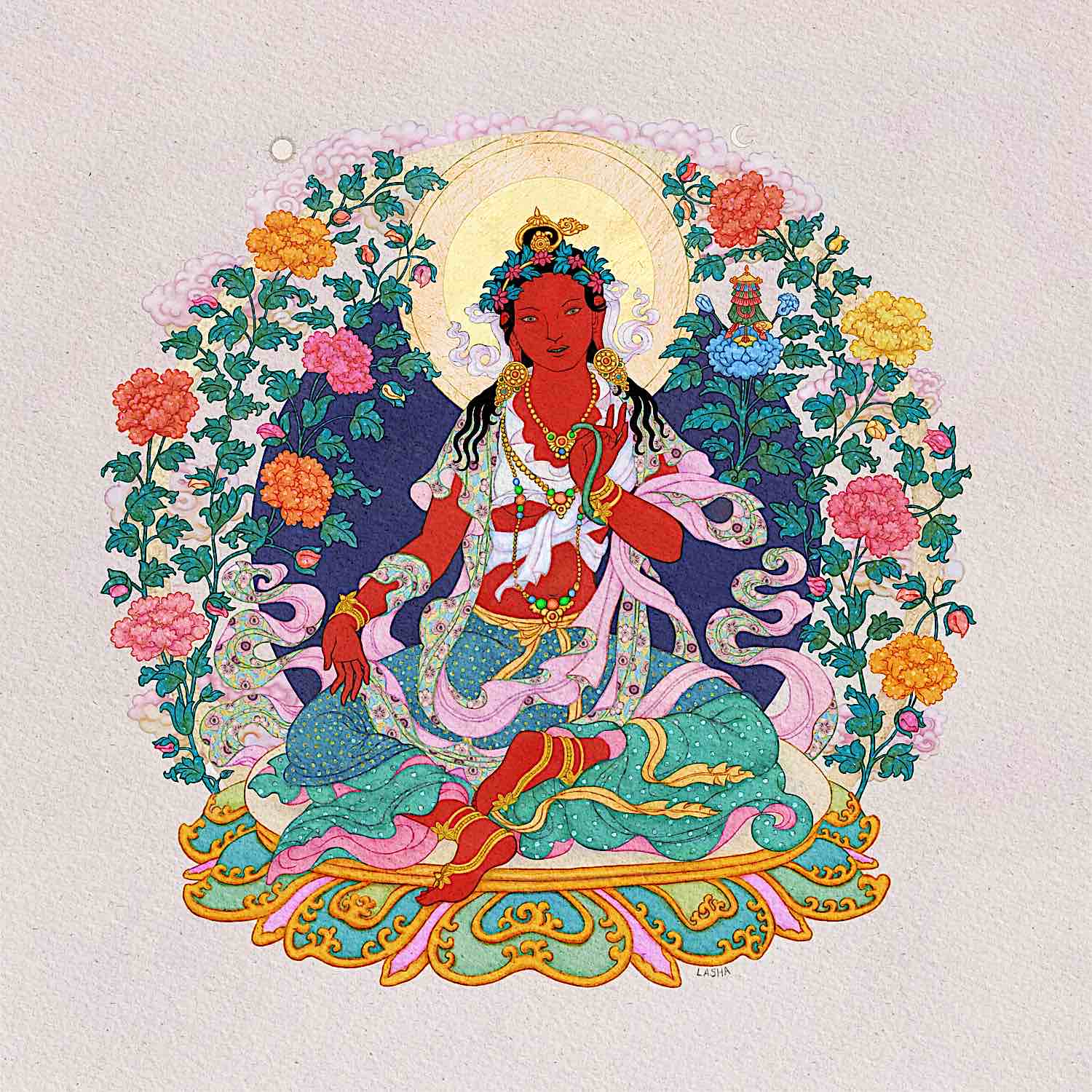
Tara 10 is Tara who conquers the three worlds, called Drolma Jikten Sumgyal. She is red with a victory banner and subdues worldly distractions.
Tara 10
Homage to You, the majestic and joyful
With brilliant garlands of light around your crown
With the great clangor of laughter TUTTARA
Over power all the worlds and the maras.
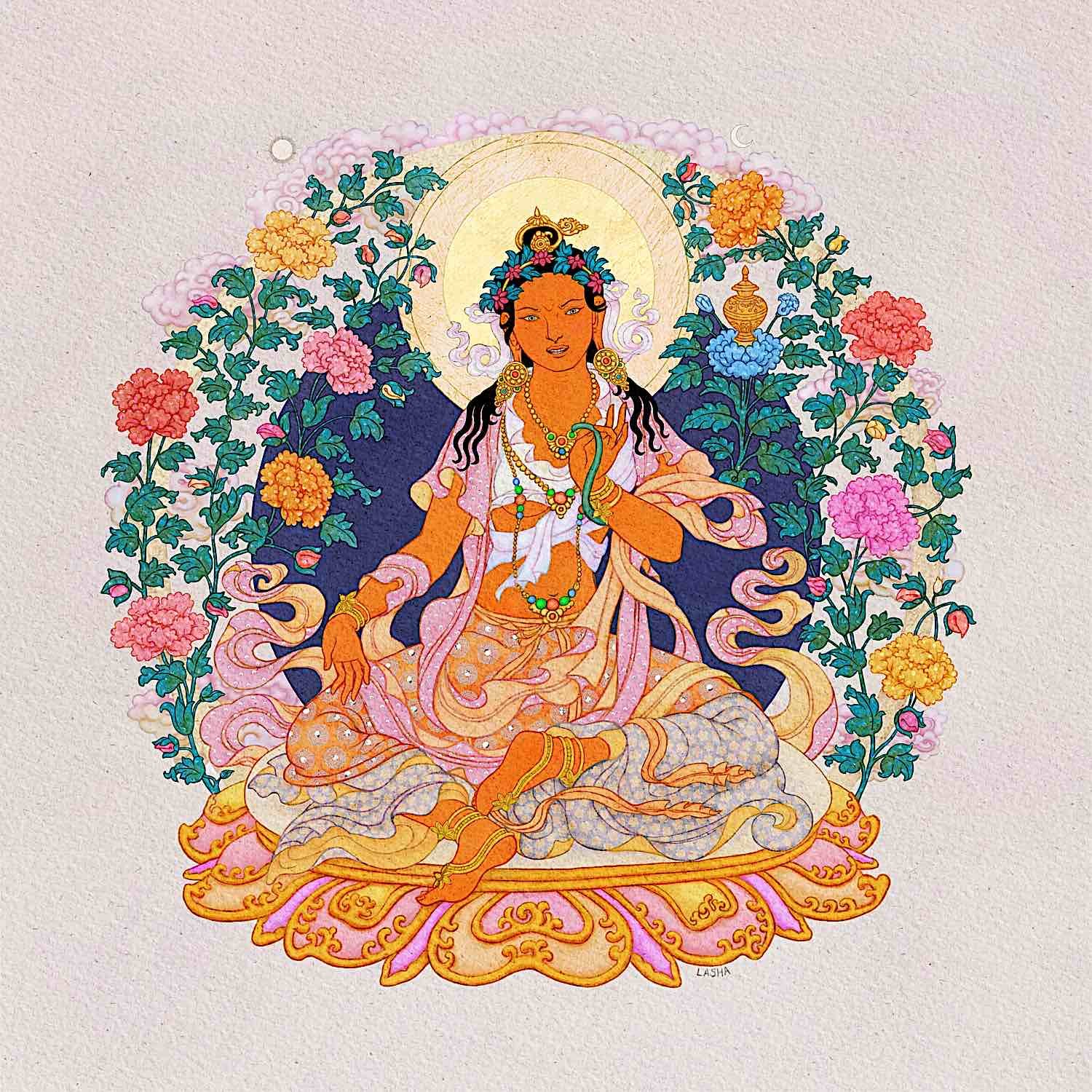
Tara 11 is Tara who bestows wealth, called Drolma Nor Terma. She is orange with a Treasure Vase, and her activity is wealth, removing the suffering of poverty.
Tara 11
Homage to You, endowed with the great power,
To draw assembly of worldly guardians.
The One who with the HUM of wrathful wrinkles
You rescue completely from all poverty.

Tara 12 is Tara who brings auspiciousness, called Drolma Tashi Dönché. She is yellow with an infinity knot, and her activity is inner/outer balance, seasons, and harvests.
Tara 12
Homage to You, who is crowned with crescent moon,
And whose ornaments so brilliantly sparkle.
Amitabha in front of your ushnisha,
Eternally radiating beams of light.

Tara 13 is Tara who destroys the power of enemies, called Drolma Drapung Jomma. She is dark red with an open wrathful vajra, who stops warfare, and heals destruction from anger.
Tara 13
Homage to You, who dwell in garlands of flames
Engulfed in fire like the end of the aeon.
Right leg outstretched and left bent with blissful joy
Who with your power destroy all enemies.

Tara 14 is Tara furrowing her brow, called Drolma Tronyer Chendze. She is Blue-black in color, with her symbol the tung shing pestle. Her activity removes subtle negativities and obstacles.
Tara 14
Homage to You, striking the ground with your hand
And crushing the earth with your majestic foot.
With wrathful, wrinkled face and the sound of HUM
You fully subdue seven levels of worlds.
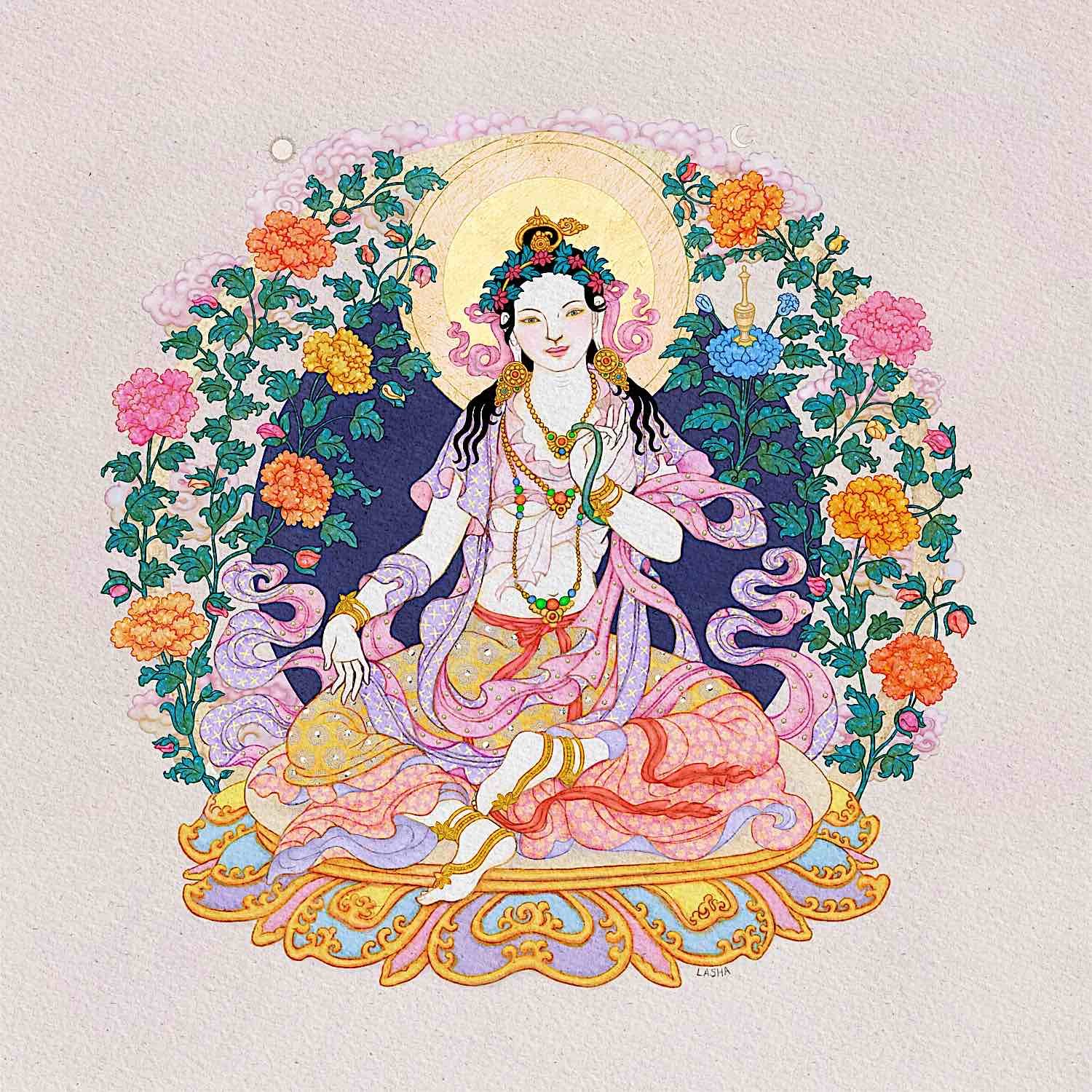
Tara 15 is Tara who is perfect peace, called Drolma Rabtu Shyiwa. She is white, and her vase pacifies evil and obscurations.
Tara 15
Homage to You, happy, virtuous and peaceful,
Who acts from eternal bliss of Nirvana.
And who with the pure sounds of OM and SVAHA,
Eliminates the most unwholesome Karmas!

Tara 16 is Tara who is ablaze with light, called Drolma Barwé Öchen. She is red with a double dorje (vajra), and her activity destroys negative intentions.
Tara 16
Homage to You, who turns the Wheel of Dharma
For truly devoted, who love the teachings
Crushing enemies — all types of obstacles
with the Hum and the ten-syllable mantra.

Tara 17 is Tara of limitless subjugation, called Drolma Pakmé Nönam. She is orange golden with her symbol a stupa, and her activity stops violent activity such as robbery and hunting.
Tara 17
Homage to You with feet stamping and Ture
Whose essence is the sacred syllable Hum.
You cause Mount Meru, Mandhara and Vindhya
Making all three worlds to tremble and shake!
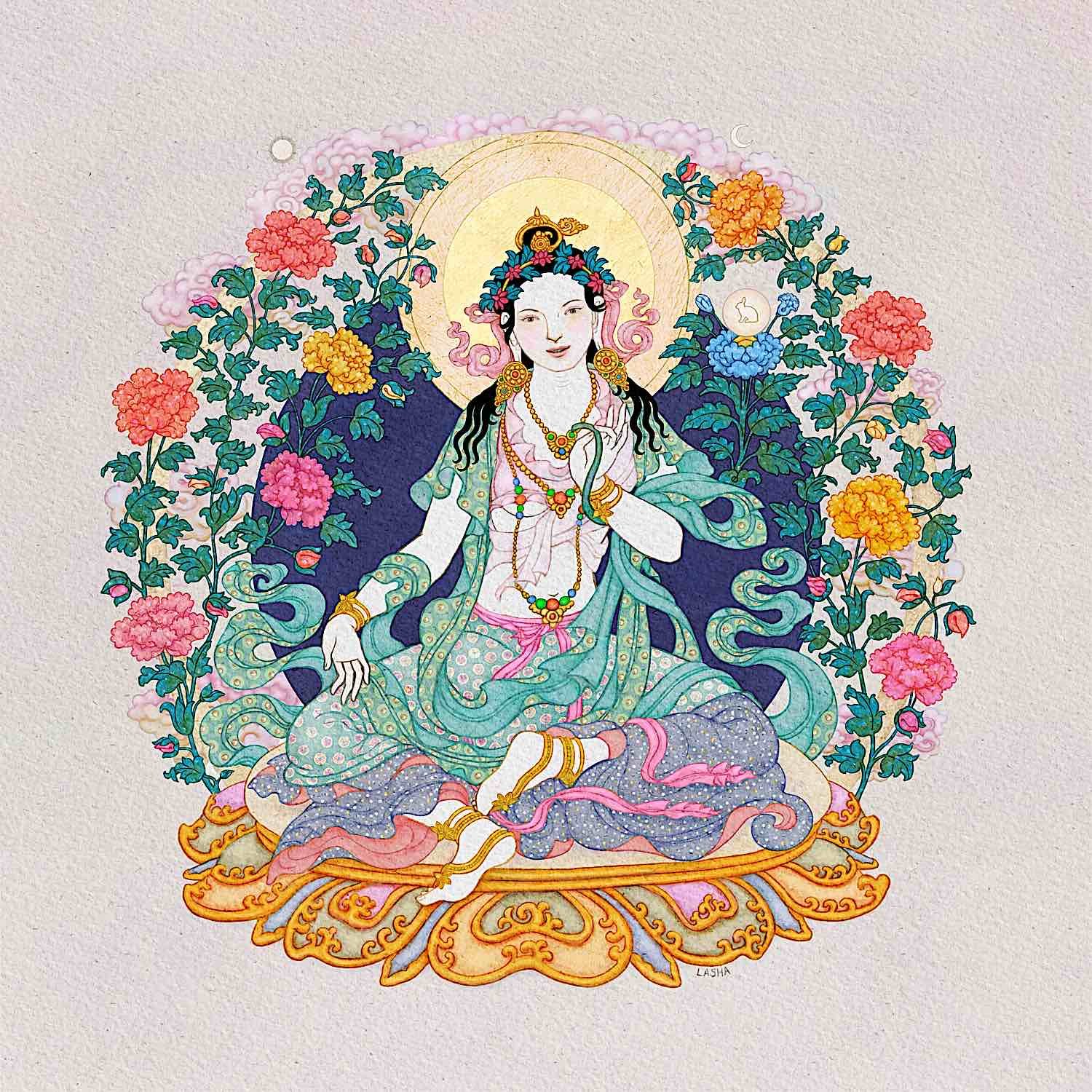
Tara 18 is Tara who cleanses all poisons, called Drolma Mabja Chenmo. Her symbol is the white rabbit-marked moon (hare moon) and she protects against inner and outer poisons and protects children.
Tara 18
Homage to You, holding the moon in Your hand
Like a celestial ocean of nectar.
Sound of the PEY and the twice uttered TARA
You completely dispel every poison.

Tara 19 is Tara who is unconquerable and victorious, called Drolma Mipam Gyalmo. She is white with an umbrella and protects from conflicts, bad omens bad dreams.
Tara 19
Homage to You on whom the devas rely
And also the lords of all the Gandharvas.
Your armor of joy, a radiant brightness,
You eliminate arguments and nightmares.

Tara 20 is Tara who protects from epidemics, called Drolma Ritröma. She is saffron color and has a medicine filling a round vessel. She dispels epidemics and deadly illnesses.
Tara 20
Homage to You, whose two eyes are shining bright,
Brilliant with light like the sun and the full moon.
Saying HARA twice and TUTTARE again
You clear and eliminate epidemics.

Tara 21 is Tara Marici Drolma Özer Chenma. She is white with two golden fish. Her activity protects life, and longevity, and also protects animals.
Tara 21
Homage to You whose pure Body, Speech and Mind
Are perfect with the strength and power of peace.
Suppressing Maras, Dons, Zombies and Yakshas
With the most exalted syllable TURE.
English without the 11 beats
Venerable Zasep Rinpoche’s careful English translation (without equal beats) is reproduced below from his beautiful book Tara in the Palm of Your Hand:
Tara 1
Homage to you, the Swift One, the Heroine,
Whose eyes are like an instant flash of lightning,
Who arose from the open corolla
Of the lotus face of the Lord of the Three Worlds.
Tara 2
Homage to you whose face is like one hundred autumn moons
Completely full, and gathered into one,
Radiating a great and distinguished light,
Superior to the gathering of a thousand stars.
Tara 3
Homage to you who are golden blue,
Whose hands are beautifully decorated with a water-born lotus;
Who embody the Six Perfections of giving, moral discipline,
Patience, perseverance, concentration, and wisdom.
Tara 4
Homage to you, who crown the Buddhas’ ushnishas,
Whose victorious actions are without limit,
Who have attained all transcendental wisdoms without exception,
And on whom the Bodhisattvas themselves rely.
Tara 5
Homage to you, who, uttering TUTTARE and HUM,
Fill the worlds of desire, direction and space,
Who with your feet press down the seven worlds,
And who by your power draw all beings without exception.
Tara 6
Homage to you to whom Indra, Agni,
Brahma, Vayu, Ishvara and the other gods offer prayers,
And who are praised by spirits, zombies,
Smell-eaters and Yakshas.
Tara 7
Homage to you who with the mantras TRA and PHAT
Completely destroy all the magic wheels,
Crushing them with your right leg bent and your left stretched out,
Burning them completely in a blazing whirl of fire.
Tara 8
Homage to you, TURE, the Great Fierce One,
Who totally destroy the leaders of the maras,
Whose lotus face forms wrathful wrinkles,
And who annihilate all enemies without exception.
Tara 9
Homage to you whose fingers, held at your chest,
Are in the mudra of the Three Jewels;
The gathered light from your hands,
Decorated with wheels, extends in all directions.
Tara 10
Homage to you who are so joyful,
With a garland of light around your crown,
And whose great laughter of TUTTARA
Overpowers all the worlds and maras.
Tara 11
Homage to you, endowed with the power
To draw the assembly of worldly guardians,
The One who with the HUM of wrathful wrinkles
Rescues completely from all poverty.
Tara 12
Homage to you who are crowned with a crescent moon,
And whose ornaments shine brightly,
With Amitabha Buddha seated in front of your ushnisha
Eternally sending forth beams of light.
Tara 13
Homage to you who dwell within a garland of flames
Like the fire at the end of the aeon;
With your right leg outstretched and your left bent with joy,
You destroy all enemies.
Tara 14
Homage to you who strike the ground with the palm of your hand
And trample it with your foot;
With a wrathful, wrinkled face and the sound of HUM,
You subdue all seven levels of the world.
Tara 15
Homage to you, the happy, virtuous, peaceful one,
Who act from the eternal bliss of Nirvana,
And who with the pure sounds of SOHA and OM
Eliminate even the strongest unwholesome Karmas.
Tara 16
Homage to you who turn the sharp Wheel of Dharma
For those who love the teachings,
And who crush all inner and outer enemies,
With the ten-syllable mantra and the seed syllable HUM.
Tara 17
Homage to you who stamp your feet while reciting the sound of TURE,
Whose essence syllable is HUM;
You cause Mount Meru, Mandhara and Vindhya
And all three worlds to tremble and shake.
Tara 18
Homage to you who hold in your hand
A beautiful moon resembling a celestial lake;
Saying TARA twice, and the letter PHAT
You dispel poisons completely and forever.
Tara 19
Homage to you on whom the lords of the hosts of devas rely,
And also the lords of the Gandharvas;
By the splendor of your joyful armour,
You eliminate arguments and nightmares as well.
Tara 20
Homage to you whose two eyes
Are so beautiful and bright, like the sun or moon;
Saying HARA twice, and TUTTARE again
You quell and eliminate the most fearful epidemics.
Tara 21
Homage to you who by embodying the three Ultimates
Are perfect with the strength of peace,
Able to eliminate maras, Dons, zombies, and Yakshas;
TURE is the most exalted syllable of the Supreme.
21 Tara Praise in Sanskrit
Om namah spukasam namah Taraye mi Tara
1 Namas Tare Ture vire
kshanair dyuti nibhekshane
trailokya nat ha vaktrabja
vikasat kesharobhave
2 Namah shata sharac chandra
sampurna patalanane
Tara sahasra nikara
prahasat kira noj jvale
3
Namah kanaka nilabja
pani padma vibhu shite
dana virya tapah shanti
titik sha dhyana gochare
4
Namas tat hagatosh nisha
vijayananta charini
ashesha paramita prapta
jina putra nishevite
5
Namas Tuttara Hum kara
puritasha dig antare
sapta loka kramakranti
asheshak arshanak shame
6
Namah shakranala Brahma
marud vishvesh varachite
bhuta vetala gand harva
gana yaksha puras krte
7
Namas trad iti phat kara
para yantra pramardani
praty alid ha pada nyase
shik hi jvalakulek shane
8
Namas Ture maha ghore
mara vira vinashani
bhrku ti krta vaktrabja
sarva shatrum nishudani
9
Namas tri ratna mudranka
hrdyanguli vibhushite
bhu shitashesha dik chakra
nikara sva Karakule
10
Namah pramudita topa
muku ta kshipta malini
hasat prahasat Tuttare
mara loka vashamkari
11
Namah samanta bhu pala
patalakarshana kshame
chalat bhrku ti hum kara
sarvapada vimoch ani
12
Namah shikhanda kandendu
muku tabha ranojjvale
Amitabha jata bhara
bhasvare kirana dhruve
13
Namah kalpanta hutabhug
jvala malan Tara sthite
alidha muditabandha
ripu chakra vinashani
14
Namah kara talaghata
charana hata bhu tale
bhrkuti krta Hum kara
sapta patala bhedini
15
Namah shive shubhe shante
shanta nirvana gochare
svaha pranava samyukte
maha papaka na shani
16
Namah pramudi tabandha
ripu gatra vabhedini
dashakshara pada nyashe
vidya Hum kara dipite
17
Namas Ture pada ghata
Hum karakara bijite
meru mandara kailasa
bhuvana traya chalini
18
Namah sura sarakara
harinika karast hite
Tara dvir ukta Phat kara
ashesha visha nashani
19
Namah sura ganadh yaksha
sura kimnara sevite
abandha mudita bhoga
kali duhs vapna nashani
20
Namah chandrarka sampurna
nayana dyuti bhas vare
hara dvir ukta Tuttare
vishama jvara nashani
21
Namas tri tattva vinyasa
shiva shakti saman vite
graha vetala yakshaugha
nashani pravare Ture
21 Taras Praise in Tibetan
Chhag tshäl dröl ma nyur ma pa mo
Chän ni kä chig log dang dra ma
Jig ten sum gön chhu kye zhäl gyi
Ge sar je wa lä ni jung ma
Chhag tshäl tön käi da wa kün tu
Gang wa gya ni tseg päi zhäl ma
Kar ma tong thrag tshog pa nam kyi
Rab tu chhe wäi ö rab bar ma
Chhag tshäl ser ngo chhu nä kye kyi
Pä mä chhag ni nam par gyän ma
Jin pa tsön drü ka thub zhi wa
Zö pa sam tän chö yül nyi ma
Chhag tshäl de zhin sheg päi tsug tor
Tha yä nam par gyäl war chö ma
Ma lü pha röl chhin pa thob päi
Gyäl wäi sä kyi shin tu ten ma
Chhag tshäl TUTTARA HUM yi ge
Dö dang chhog dang nam kha gang ma
Jig ten dün po zhab kyi nän te
Lü pa me par gug par nü ma
Chhag tshäl gya jin me lha tshang pa
Lung lha na tshog wang chhug chhö ma
Jung po ro lang dri za nam dang
Nö jin tshog kyi dün nä tö ma
Chhag tshäl TRAD che ja dang PHAT kyi
Pha röl thrül khor rab tu jom ma
Yä kum yön kyang zhab kyi nän te
Me bar thrug pa shin tu bar ma
Chhag tshäl TURE jig pa chhen po
Dü kyi pa wo nam par jom ma
Chhu kye zhäl ni thro nyer dän dzä
Dra wo tham chä ma lü sö ma
Chhag tshäl rab tu ga wa ji päi
U gyän ö kyi threng wa pel ma
Zhe pa rab zhä TUTTARA yi
Dü dang jig ten wang du dzä ma
Chhag tshäl sa zhi kyong wäi tshog nam
Tham chä gug par nü ma nyi ma
Thro nyer yo wäi yi ge HUM gi
Phong pa tham chä nam par dröl ma
Chhag tshäl da wäi dum bü u gyän
Gyän pa tham chä shin tu bar ma
Räl päi khur na ö pag me lä
Tag par shin tu ö rab dzä ma
Chhag tshäl käl päi tha mäi me tar
Bar wäi threng wäi ü na nä ma
Yä kyang yön kum kün nä kor gäi
Dra yi pung ni nam par jom ma
Chhag tshäl sa zhii ngö la chhag gi
Thil gyi nün ching zhab kyi dung ma
Thro nyer chän dzä yi ge HUM gi
Rim pa dün po nam ni gem ma
Chhag tshäl de ma ge ma zhi ma
Nya ngän dä zhi chö yül nyi ma
SVAHA OM dang yang dag dän pä
Dig pa chhen po jom pa nyi ma
Chhag tshäl kün nä kor rab ga wäi
Dra yi lü ni nam par gem ma
Yi ge chu päi ngag ni kö päi
Rig pa HUM lä dröl ma nyi ma
Chhag tshäl TURE zhab ni deb pä
HUM gi nam päi sa bön nyi ma
Ri rab Mandhara dang big je
Jig ten sum nam yo wa nyi ma
Chhag tshäl lha yi tsho yi nam päi
Ri dag tag chän chhag na nam ma
TARA nyi jö PHAT kyi yi ge
Dug nam ma lü pa ni sel ma
Chhag tshäl lha yi tshog nam gyäl po
Lha dang mi am chi yi ten ma
Kün nä go chha ga wäi ji gyi
Tsö dang mi lam ngän pa sel ma
Chhag tshäl nyi ma da wa gyä päi
Chän nyi po la ö rab säl ma
HARA nyi jö TUTTARA yi
Shin tu drag pöi rim nä sel ma
Chhag tshäl de nyi sum nam kö pä
Zhi wäi thü dang yang dag dän ma
Dön dang ro lang nö jin tshog nam
Jom pa TURE rab chhog nyi ma
- In part 2 of this series, we compare the visualizations and attributes of the various lineages.

Lasha Mutual. You can reach her through her website, facebook or instagram linked below.
About Lasha Mutual, the artist
Please visit Lasha Mutual website for a full online gallery.
Or, join thousands of fans and follow Lasha’s art on Facebook and Instagram:
www.facebook.com/lashamutualart/
www.instagram.com/lashamutual/
SOURCES
[1] Tara in the Palm of Your Hand, Venerable Zasep Rinpoche, Windhorse Press.
[2] Khenchen Palden Sherab;Khenpo Tsewang Dongyal. Tara’s Enlightened Activity: An Oral Commentary On The Twenty-One Praises To Tara (Kindle Location 409). Kindle Edition.
[3] Praises to the 21 Taras, FPMT (this link downloads a PDF>>)
Amazon links may be affiliate links.

